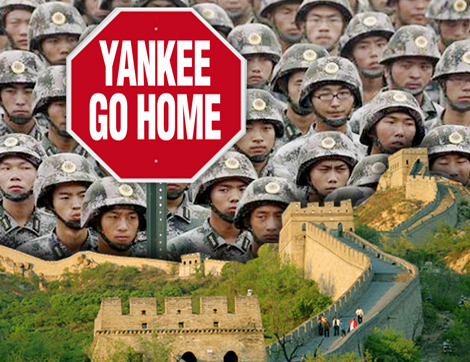
By Richard Walker
A war with China is a real possibility.
All it might take is the kind of near collision between United States and Chinese naval vessels that happened recently in the East China Sea or a dog fight between Japanese and Chinese fighter planes in the skies over the disputed Senkaku Islands in the East China Sea. It could also start with a confrontation between Philippine and Chinese vessels in energy-rich parts of the South China Sea now claimed by Beijing.
There have been many close calls lately as China begins to assert itself around the world, and most experts admit that once the genie is out of the bottle it will be impossible to put it back in. This may have already occurred.
In December 2012, Japan scrambled fighters after Chinese surveillance planes were spotted over the Senkaku Islands, territory China has since declared a Chinese air defense zone.
Japan has been concerned by China’s use of drones close to its airspace and has vowed to retaliate by deploying U.S. made drones like the Global Kitty Hawk it hopes to buy from Washington. China has been developing its own drones, most likely with stolen U.S. technology. Some experts have forecast there will be a drone war in the region before long.
Since his inauguration, President Barack Obama, like his predecessor, George W. Bush, has paid little heed to China’s growing naval ambitions. He has ignored repeated warnings from allies like India, Japan, Australia, Vietnam, the Philippines and South Korea that the Chinese have been building a formidable military that has been shaped specifically to dominate the Western Pacific.
Neocons, who want America to continue to meddle around the world, issued warnings as far back as 2005 when Robert D. Kaplan wrote in The Atlantic Monthly that if China moved into the Pacific it would encounter a “U.S. Navy and Air Force unwilling to budge from the coastal shelf of the Asian mainland,” resulting in a “replay of the decades-long Cold War, with a center of gravity not in the heart of Europe but among Pacific atolls.”
In AMERICAN FREE PRESS in 2007, this reporter wrote that China was not many years away from challenging U.S. dominance in Asia. At the time, a Council on Foreign Relations (CFR) task force had recommended the U.S. needed to “defeat China swiftly and decisively in any military conflict.”
The CFR recommended expanding U.S. forces into Asia and shifting the balance of its naval and maritime power from the Atlantic to the Pacific. Globalists also wanted the U.S. to “invest heavily in new technologies appropriate for a naval and air battle with the Chinese.”
Since 2007, with an eye to defeating the U.S. in a war in the region, China has greatly expanded its short-and medium-range ballistic missile arsenal, giving it the capability to target all U.S. bases in Japan, Taiwan, South Korea and the Philippines. It has also new anti-ship missiles capable of destroying U.S. aircraft carriers.
By using an overwhelming number of short-and medium-range missiles, the Chinese could destroy U.S. bases and make resupply difficult in a future conflict. As the National Air Space Intelligence Center has pointed out, “China has the most active and diverse ballistic missile development program in the world.”
A sign of how the U.S. might react in the opening exchanges of a conflict was contained in a Pentagon document leaked to The Washington Post in 2012. It talked of a plan that envisioned the U.S. destroying China’s surveillance and missile targeting capabilities “deep inside the country.” The plan talked of a “blinding campaign” followed by a massive naval and air assault—the same “shock and awe” tactic used against Iraq, which resulted in scores of dead civilians.
The assumption here is that China would not go nuclear once the missiles started flying. The bottom line is this could be the defining war
of the 20th century if Washington refuses to bring U.S. troops and ships home and let Asia sort out its own troubles.


